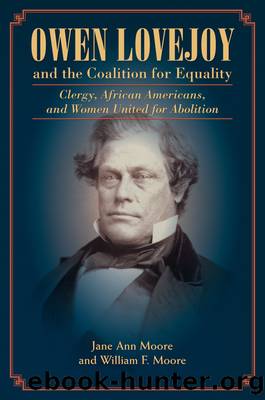Owen Lovejoy and the Coalition for Equality by Jane Moore William Moore

Author:Jane Moore, William Moore [Jane Moore, William Moore]
Language: eng
Format: epub
Tags: Social Science, General, Slavery, Religion, Religion; Politics & State, History, United States, 19th Century
ISBN: 9780252051142
Google: u2alDwAAQBAJ
Publisher: University of Illinois Press
Published: 2019-12-20T03:18:44+00:00
Women Go to Springfield and the âBlack Trioâ Tours Northern Illinois
In Illinois, radical women focused on electing Republican candidates to contain slavery. A smaller group of womenâs rights advocates was pressing state legislators to change laws concerning women.85 Antislavery leaders Hannah Cutler and Frances D. Gage, visiting from out of state, lobbied extensively in Chicago and Springfield for a married womanâs property bill that would allow women to own and dispose of their own property, but in 1859 it failed to pass in the state legislature. That year the only new legislation women obtained was the right to reclaim their original surname after divorce.86 The Married Womenâs Property Act would not pass until February 1861.
Eunice owned Butler Denhamâs farm in her own name because Butler had designated it to her in his will. Lovejoy respected his friendâs decision and did not request a transfer of the property to his name, even though, when he married Eunice in 1843, he had a legal right to do so.
In February 1859, Frederick Douglass traveled to Chicago by train from his home in Rochester, New York, to be the guest of honor at a gala reception at Quinn Chapel, the AME Church on Jackson Street. The next day Douglass, John Jones, and H. Ford Douglas began another interracial campaign tour by train. This trip lasted for an arduous seven weeks.87 The men went with the coalitionâs blessing to test public opinion prior to the 1860 presidential election. Douglass believed it was changing: âThe public sentiment has been gradually rising. ⦠We think a Negro lecturer an excellent thermometer of the state of public opinion on the subject of slavery, much better than a white man. ⦠Put him in a rail car, in a hotel, in a church, and you can easily tell how far those around him have got from barbarism towards a true Christian civilization.â88
The trio gave nearly fifty speeches in Illinois towns and villages, starting with Waukegan, Bloomington, Elgin, Belvidere, and Rockford. H. Ford Douglas had lived in Rockford previously and was known there. In Rockford, despite severe cold, they addressed audiences of four to five hundred on February 9 and 10, 1859.89 Fordâs lecture was titled âThe Essential Wickedness of Slavery.â Next, the trio spoke in Janesville and Beloit, Wisconsin, before returning to Illinois to visit Freeport, Dixon, Mendota, Princeton, Galesburg, Peoria, Ottawa, Morris, and places in between. The people of many of these towns were Lovejoyâs constituents. These three black men were witnessing to their own humanity and that of all African Americans. Frederick Douglass recounted, âTimes have changed very much of late. The Abolition lecturer speaks to a different audience, moves in a different atmosphere, and treads a less rugged pathway. ⦠Those who came to hear us, were confessedly the most valuable and intelligent of the people in each community visited. ⦠Slavery was really the thought uppermost in the minds of our hearers.â90
When Douglass, Douglas, and Jones returned to Chicago, they spent several days together debriefing as guests in the homes of their closest white antislavery colleagues.
Download
This site does not store any files on its server. We only index and link to content provided by other sites. Please contact the content providers to delete copyright contents if any and email us, we'll remove relevant links or contents immediately.
| United States | Abolition |
| Campaigns & Battlefields | Confederacy |
| Naval Operations | Regimental Histories |
| Women |
In Cold Blood by Truman Capote(2702)
Steve Jobs by Walter Isaacson(2459)
All the President's Men by Carl Bernstein & Bob Woodward(1972)
Lonely Planet New York City by Lonely Planet(1857)
The Murder of Marilyn Monroe by Jay Margolis(1752)
The Room Where It Happened by John Bolton;(1729)
The Poisoner's Handbook by Deborah Blum(1671)
And the Band Played On by Randy Shilts(1632)
Lincoln by David Herbert Donald(1622)
The Innovators by Walter Isaacson(1612)
A Colony in a Nation by Chris Hayes(1530)
The Innovators: How a Group of Hackers, Geniuses, and Geeks Created the Digital Revolution by Walter Isaacson(1519)
Under the Banner of Heaven: A Story of Violent Faith by Jon Krakauer(1425)
The Unsettlers by Mark Sundeen(1347)
Amelia Earhart by Doris L. Rich(1346)
Birdmen by Lawrence Goldstone(1346)
Decision Points by George W. Bush(1261)
Dirt by Bill Buford(1247)
Zeitoun by Dave Eggers(1231)
